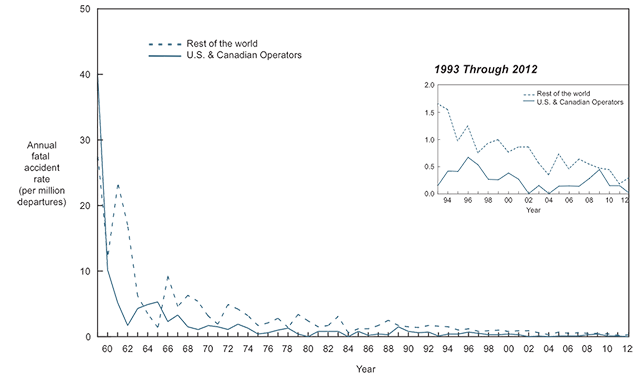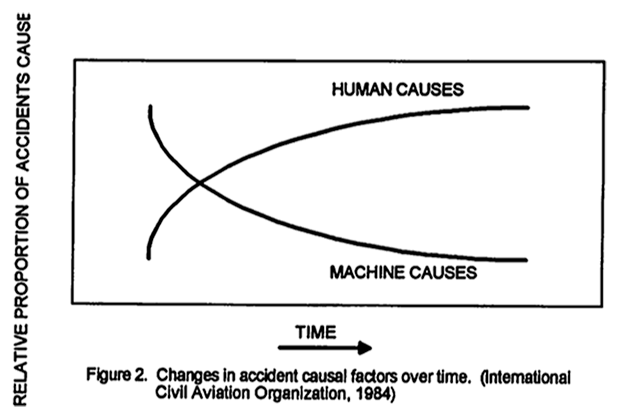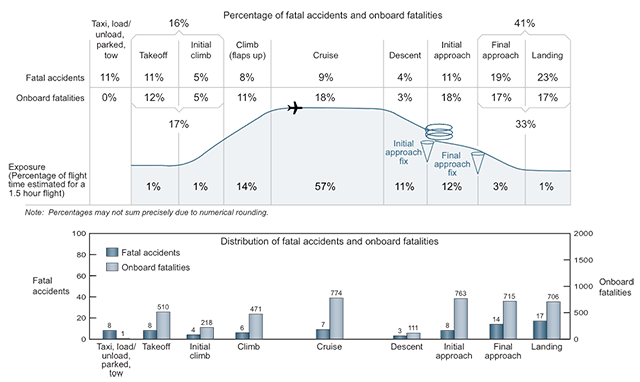The cleverest trick by someone arguing a point without facts is to use a twist of statistics to prove a point. Here is where we find accident rates and the claim pilots are letting the world down by not holding their end of the man/machine equation. Look at the chart below, accident rates have plummeted. (True). Look at the chart below that, accidents caused by pilots are way up! (Not true.)
— James Albright

Updated:
2015-04-03

US/Canadian Operators Accident Rates by Year, from Boeing Statistical Summary, pg. 17.

Changes in accident causal factors over time, from CRM Handbook, figure 2.
The percentage of accidents caused by pilots is indeed up. But the number is down, even in the face of many more flights, many more airplanes, and many more pilots.
None of this is to excuse pilot error as a cause of accidents. We should continue to strive for improvement. But don't let the faux statisticians make you think it is a lost cause. It isn't.
The big picture falling accident rates (on the top of the page) leads one to believe we have this aviation thing figured out. The decline has been so sharp that it is undeniable that things have gotten better. While a lot of that is because we are smarter, most of it is because we are smarter at building airplanes.
An ICAO study notes that the proportion of accidents caused by humans is way up. Of course this is statistical hocus pocus. While the number of accidents has gone down, the number caused by mechanical problems has gone way down. Human issues have no place to go but up. I would argue that we as pilots have made great strides as well, but we can and should improve.

1
Summary by phase of flight

Fatal accidents by phase of flight, from Boeing Statistical Summary, pg. 20.
2
Basis
The chart on the top of this page is based on the following:
- The accident statistics presented in this summary are confined to worldwide commercial jet airplanes that are heavier than 60,000 pounds maximum gross weight. Within that set of airplanes, there are two groups excluded:
- Airplanes manufactured in the Commonwealth of Independent States (CIS) or the Union of Soviet Socialist Republics (USSR) are excluded because of the lack of operational data; and
- Commercial airplanes operated in military service. (However, if a military-owned commercial jet transport is used for civilian commercial service, those data will be included in this summary.)
- The following airplanes are included in the statistics:
707/720 717 727 737 747 757 767 777 787
DC-8 DC-9 DC-10/MD-10 MD-11 MD-80/-90
A300 A300-600 A310 A320/321/319/318 A330 A340 A380
EMB-170/-175 EMB-190/-195
Concorde
L-1011
BAC 1-11 Comet 4 Trident Caravelle Mercure CV-880/-990 VC-10 BAe 146 F-28 Avro RJ-70/-85/-100 F-70
CRJ-700/-900/-1000
F-100
Source: Boeing Statistical Summary, page 2.
3
Situational awareness case studies
Situational awareness is not just a theoretical notion and is pertinent to most accident or incident cases. It is real, and its absence causes accidents. Research from the Australian Transportation Safety Board (ATSB) indicates that human factors is a contributing cause in around 70 percent of all incidents and accidents. Approximately 85 percent of incident reports include a mention of loss of situational awareness. Degraded situational awareness can lead to inadequate decision making and inappropriate actions. This is illustrated in [the table], which identifies causal factors involved in approach and landing accidents.
| Factor | % of Events |
| Inadequate decision making | 74% |
| Omission of action or inappropriate action | 72% |
| Non-adherence to criteria for stabilized approach | 66% |
| Inadequate crew coordination, cross-check and back-up | 63% |
| Insufficient horizontal or vertical Situational Awareness | 52% |
| Inadequate or insufficient understanding of prevailing conditions | 48% |
| Slow or delayed action | 45% |
| Flight handling difficulties | 45% |
| Deliberate non-adherence to procedures | 40% |
| Inadequate training | 37% |
| Incorrect or incomplete pilot/controller communication | 33% |
| Interaction with automation | 20% |
Causal factors in approach and landing accidents
Source: Airbus Flight Operations Note, pg. 2
References
(Source material)
Airbus Flight Operations Briefing Notes: Enhancing Situational Awareness.
Crew Resource Management: An Introductory Handbook, DOT/FAA/RD-92/26, DOT-VNTSC-FAA-92-8, Research and Development Service, Washington, DC, august 1992
Statistical Summary of Commercial Jet Airplane Accidents, Worldwide Operations 1959 - 2012, Boeing Commercial Airplanes, 2013